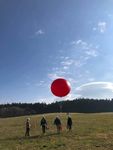UNISEC-Hands-on Training ARLISS and CLTP - during the pandemic Rei Kawashima UNISEC-Global, UNISEC-Japan - UNISEC Global
←
→
Page content transcription
If your browser does not render page correctly, please read the page content below
UNISEC-Hands-on Training
during the pandemic
ARLISS and CLTP
Rei Kawashima
UNISEC-Global, UNISEC-Japan
© 2021 UNISEC. All rights reserved. 1ARLISS 1999-2019
A Rocket launch for International Student Satellites
• CanSat experiment and competition
– AeroPAC (amateur rocket group) provides rockets (up to 4 km) in
Blackrock desert, Nevada, USA
– About 100 students attended from Japan every year and students
from more than 10 countries joined.
No ARLISS in 2020
Not sure In 2021
Ken Biba of
AeroPAC will
present ARLISS
on March 20
© 2021 UNISEC. All rights reserved. 2CanSat Experiment in Asagiri plateau in
Shizuoka (near Mt. Fuji) in 2020 Dec
• UNISEC-Japan students found a new location for
CanSat experiments in Japan.
• Using balloon for “launch.”
• What is needed should be considered with
innovative, imaginative spirits.
© 2021 UNISEC. All rights reserved. 3CanSat Leader Training Program (CLTP) Objective: CLTP is a training program for professors/instructors to learn how to conduct CanSat (or HEPTA-Sat) training by experience. Participants are expected to teach their students after training. It has contributed to capacity building in basic space engineering and technology. Launched: October 2010 (1st CLTP was held in 2011) Offered: Annually Graduated: 96 participants from 46 countries © 2021 UNISEC. All rights reserved. 4
CLTP History & Participants (1)
96 participants from 46 countries
CLTP1 (Wakayama Univ. in Feb-March, 2011)
12 participants from 10 countries, Algeria, Australia, Egypt, Guatemala,
Mexico, Nigeria, Peru, Sri Lanka, Turkey (3), Vietnam.
CLTP2 (Nihon Univ. in Nov-Dec, 2011)
10 participants from 10 countries, Indonesia, Malaysia, Nigeria, Vietnam,
Ghana, Peru, Singapore, Mongolia, Thailand, Turkey.
CLTP3 (Tokyo Metropolitan Univ. in July-August, 2012)
10 participants from 9 countries, Egypt (2), Nigeria, Namibia, Turkey,
Lithuania, Mongolia, Israel, Philippines, Brazil.
CLTP4 (Keio Univ. in July-August, 2013)
9 participants from 6 countries, Mexico(4), Angola, Mongolia,
The Philippines, Bangladesh, Japan.
CLTP5 (Hokkaido Univ. in Sept 8-19, 2014)
7 participants from 5 countries, Korea (2), Peru, Mongolia,
Mexico (2), Egypt.
CLTP6(Hokkaido Univ. in August 24-Sept4, 2015)
8 participants from 8 countries, namely Angola, UN(Austria),
New Zealand, Tunisia, Turkey, Egypt, Bangladesh, Mexico
CLTP7 (Hokkaido Univ. in Sep 21‐Oct 1, 2016)
8 from 7 countries, namely Egypt, Myanmar, Peru, Nepal (2), Mongolia,
Serbia, Dominican Republic
© 2021 UNISEC. All rights reserved. 5Training Programs: Educational Kits
HEPTA-Sat
(CLTP8-10, HEPTA-Sat Training Workshops)
i-CanSat (CLTP3-7, CTP)
http://unisec.jp/library/i-cansat/manual_CanSat_textbook_eng_v5.pdf
© 2021 UNISEC. All rights reserved. 6CLTP History & Participants (2)
96 participants from 46 countries
CLTP8 (Nihon Univ. in Sep 7‐Sep 16, 2017)
9 from 7 countries, namely Bolivia, Egypt, El Salvador, Malaysia, Nepal,
Turkey (+Japanese Students)
CLTP9 (Nihon Univ. in August 20- August 31, 2018)
8 from 6 countries, namely Argentina, India, Japan, Malaysia, Mongolia,
UAE (+Japanese participants for 3-day teaching practice)
CLTP10 (Nihon Univ. in August 19-August 30, 2019)
15 from 11 countries, namely Australia, Bhutan, Bulgaria, Cambodia,
Colombia, Kenya, Morocco, Myanmar, Peru, Rwanda, Zimbabwe
No CLTP
in 2020
Not sure
In 2021
© 2021 UNISEC. All rights reserved. 7Online Hands-on Training?
• Developing HEPTA-Sat Lite (simple kit)
• Planning to develop online course material
• Hardware prototype – slow development
– Original plan – August in 2020
– Reality – March in 2021?
• What is Online Hands-on Training?
– Hardware delivery to participants?
– Remote teaching through internet?
– Realtime teaching or recorded teaching?
– Is it effective?
© 2021 UNISEC. All rights reserved. 8Guiding Principles for UNISEC-Global
1. Be honest regarding project feasibility – openly recognize the technology and schedule risks that
9. Use imaginative and innovative
may impact success.
2. Build a system that can work as designed in an environment where subsequent fixing is
ways of achieving the maximum
impossible.
3. Only when you did your best to succeed, you could learn something even if you failed.
4. Remember that there are rules that you must follow - from the Outer Space Treaty to through
result using available personnel,
internal rules in your project.
technical and financial capabilities
5. Refer to the achievements of others in the past and build your own achievement on that
background.
6. Setup appropriate and realistic targets considering your capability and capacity
even if they are limited.
7. Recognize the pressure in other team members working to demanding deadlines on challenging
projects; support and help reduce their stress wherever possible.
8. Evaluate your results realistically and reflect them to your subsequent activities.
9. Use imaginative and innovative ways of achieving the maximum result using available personnel,
technical and financial capabilities even if they are limited.
Let’s get out from a small box and
10. Identify and work with your rivals and compete to stimulate innovation & mutual growth.
Recognize other people's successes and use these to stimulate yourself further.
be innovative and imaginative!
11. Respect a spirit of mutual assistance. Seek ways to contribute to others, not only seeking help
for yourself.
12. Be careful not to be misled by the "bewitching nature and allure of space" or by flattering words.
Be modest, constructively critical and sincere.
http://www.unisec-global.org/guidingprinciples.html
© 2021 UNISEC. All rights reserved. 9You can also read



























































